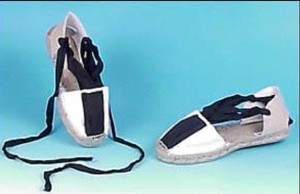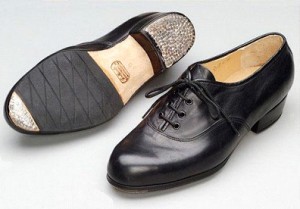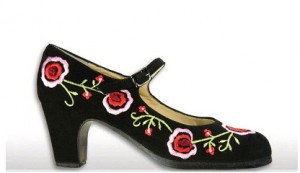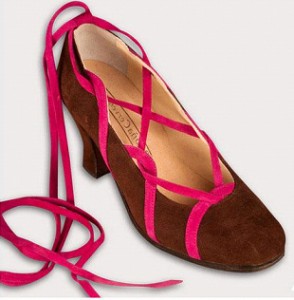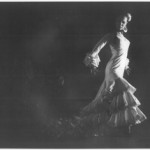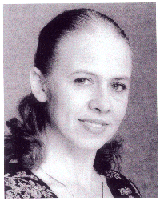As part of our continuing focus on footwear and foot care this quarter, today we are excited to bring you the basics on footwear for Spanish dance…
by Karen Stelling
The dances of Spain, loosely categorized as regional, classical, and flamenco each put a unique foot forward–quite literally! Many regional or what are traditionally called folk or peasant dances, often utilize a soft shoe, a sort of a tie-on slipper. Although they look rather flimsy, these types of shoes such as those worn in the Jota Aragonesa are quite comfortable and actually offer great cushioning for the jumping that a dance such as the Jota requires.
Spanish Classical or Ballet Espanol dances are usually performed to Spanish classical orchestrated music and are very balletic in style. The shoes preferred for Ballet Espanol have a taller, thinner and more “shapely” heel than flamenco shoes and feature a soft sole to allow greater flexibility of the foot and a more elegant line when the foot is pointed. There may be some “zapateado” or heel work in classical Spanish dance but not as intense or as deliberate as in Flamenco.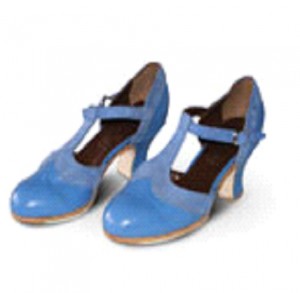 One of the most identifiable traits of flamenco dance is the intricate footwork. The shoes are the instrument the dancer uses to create and compliment the various flamenco dance rhythms. Flamenco shoes can be as varied as the dancer who wears them.
One of the most identifiable traits of flamenco dance is the intricate footwork. The shoes are the instrument the dancer uses to create and compliment the various flamenco dance rhythms. Flamenco shoes can be as varied as the dancer who wears them.
“Zapatos” need to be sturdy with solid heels but heel heights can vary depending on the dancer’s preference. Most flamenco shoes are made of smooth leather but suede is very popular and as far as colors and designs are concerned, anything is possible! Straps, ties, lace-ups are all incorporated in these shoe’s designs. Many women flamenco dancers like to coordinate their shoe color with their costumes for a unified look. Most professional flamenco shoes are hand- made in Spain and a dancer submits individual foot measurements for a custom fit.
In addition to leather soles, the toe tips and heel bottoms of flamenco shoes have tiny nails embedded into them to add a slight tapping sound when the feet hit the floor. This feature is unique to flamenco shoes. However, the real sound is produced by the strength of the dancer’s body as all her energy is directed into the lower legs and feet.
Character shoes are not the same as flamenco shoes! While character shoes can be used as Flamenco shoes for the beginner who has not decided to invest in an expensive pair of Flamenco shoes, Flamenco shoes are not interchangeable for character shoes. It is not a good idea to try and dance in Flamenco shoes for a non-Flamenco dance class. The nails at the bottom of the soles will be extremely loud and possibly damaging to the floor you are dancing on! As one might imagine, many flamenco dancers and their shoes are not especially welcome in many dance studios! The shoes pictured below are made by Begona Cervera and Gallardo, well known Spanish manufacturers.
Contributor Karen Stelling Began her Spanish Dance training in 1975 and since then has performed in many venues around Chicago, the Midwest and beyond. She was the First Dancer of the Ensemble Espanol Spanish Dance Company from its inception in 1976 through 1987, performing flamenco, neo-classical and many of the regional dances of Spain. Highlighted performances included the chance to dance with the Chicago Symphony, at the Theater of the Riverside Church in New York City, for migrant workers in the fields of Southern Illinois and in many lecture-demonstration and concerts for Chicago and suburban school students.
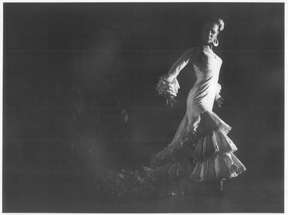
After leaving the Company, Karen continued to perform at a variety of concert halls, festivals and special events as a soloist/guest artist, and as a member of the flamenco trio, Los Tres. Karen was a guest artist and choreographer in 1999 and again in 2002 with the Ole Ole Puppet and Dance Theater directed by Wendy Clinard.
In 2007, Karen provided choreography for the Halcyon Theatre’s production of Yerma, by F. G. Lorca. Karen has taught private and group flamenco classes for over two decades including work for Hedwig Dance, the Evanston Park District, Danza Viva, Harper College Dance Program, The Salt Creek Ballet and currently at the Flamenco Arts Center and SPACE in Chicago. She received flamenco and Spanish dance training from many masters of both “old school” and the “Nuevo” styles. Karen also enjoys playing the cajon, a box drum used frequently in flamenco and teaching castanet technique.





